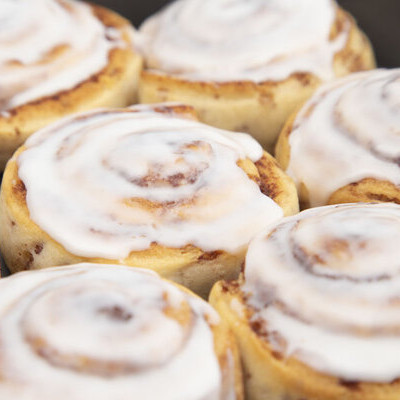
Cinnamon Roll
Also known as cinnamon bun, cinnamon swirl, cinnamon snail
What is a Cinnamon Roll?
A cinnamon roll is a sweet baked dough filled with a cinnamon-sugar filling. Made with a rich dough leavened with yeast, their characteristic form is due to rolling a dough sheet containing sweetened cinnamon filling.1
- Common toppings for cinnamon rolls include cream cheese frosting or a sugar glaze.
- Other toppings include pecans, peanuts, caramel, chocolate nut spread or chocolate sauce.1
Origin
Sweet rolls have been produced since ancient times. However, the arrival of cinnamon spice to Europe resulted in the creation of this unique sweet treat. The cinnamon rolls we know today are thought to have originated in Sweden. There, they are called kanelbulle and are celebrated on October 4th as a national holiday.2
In the US, cinnamon rolls’ popularity began in the southern states and later expanded through the whole nation.2
Ingredients
Commonly used ingredients in the production of cinnamon rolls include:1
| Ingredient | Type | Baker’s percentage | Purpose |
| Flour | All purpose or bread flour | 100 % |
|
| Sugar | White sugar (dough) and brown sugar (filling) | 15% |
|
| Fat | Butter, shortening, or margarine | 12% |
|
| Milk | Liquid milk | 2% |
|
| Salt | Fine salt | 1.5% |
|
| Yeast | Dry yeast, compressed yeast | 8% |
|
| Cinnamon | Powder | – |
|
| Eggs | Whole or egg yolk | 10% |
|
| Water | 54% |
|
Nutrition
Typical nutritional value of commercially available cinnamon rolls per 100 g:3
| Component | Grams |
|---|---|
| Carbohydrate | 50.00 |
| Water | 31.48 |
| Fat | 12.96 |
| Protein | 5.56 |
Cinnamon rolls are highly caloric bakery products due to the high levels of sugar and saturated fats. A commercial cinnamon roll provides 250 – 350 kcal per 100 g serving.3
Commercial production
Cinnamon rolls are commercially produced through the following process:1,
- Scaling and weighing ingredients separately.
- Mixing fat, sugar, milk, and flavoring thoroughly followed by flour and yeast addition to form a smooth dough.
- Dough bulk fermentation for 30 min.
- Punching to deflate the dough.
- Sheeting by rolling the dough into a sheet and further depositing the cinnamon-sugar mix on the surface and spreading it.
- Rolling the dough sheet using mechanical rolls and cutting in suitable portion size pieces.
- Final proofing and fermenting the rolls. Rich doughs are slightly under proofed for 30 – 45 minutes at 40 oC (104 oF).
- Baking cinnamon rolls for 12 -15 minutes at 205 oC (400 oF).
- Cooling down the rolls to room temperature.
- Packaging and storage.
Application
Cinnamon rolls should be produced considering the following factors:1
- Yeast activation medium (milk or water) temperature should not exceed 50 oC (120 oF).
- Yeast type: for rich doughs, osmophilic yeast is the most appropriate strain due to its capacity to grow in high sugar environments.
- Fermentation time: rich dough is slightly under-fermented (<40 min). However, when working with non osmophilic yeast fermentation time may increase 2-3 times.
- Baking temperature: cinnamon rolls should be baked at low temperatures of 175 – 205 oC (350 – 400 oF) to control browning due to the presence of milk, sugar and fat.
- Proofing time: rich doughs are slightly under-proofed (30 – 45 min) due to their weaker gluten network.
Regulations
Cinnamon rolls are included within the FDA definition of buns and rolls. Ingredients required for cinnamon rolls production are considered GRAS by the FDA.4
In the EU, coumarin a substance found in cinnamon has a maximum level of addition in baked goods of 50 mg/kg due to its potential health effects on the liver.5
References
- Handbook of Food Science, Technology, and Engineering. United Kingdom, Taylor & Francis, 2006, pp. 148-31 – 148-36.
- Thacker, E. The Cinnamon Book. Estados Unidos, James Direct, Incorporated, 2012, pp. 161..
- U.S. Department of Agriculture, Agricultural Research Service. FoodData Central, 15 August 2018. https://fdc.nal.usda.gov/fdc-app.html#/food-details/1484968/nutrients . Accessed 02 April 2021.
- “FDA Definition Of Bread And Rolls | Processes | Bakerpedia”. Bakerpedia, 2021, https://bakerpedia.com/processes/fda-bread-rolls/ . Accessed 2 Apr 2021.
- European Commission (Ec). Regulation (EC) No 1334/2008 of the European Parliament and of the Council of 16 December 2008 on flavourings and certain food ingredients with flavouring properties for use in and on foods and amending Council Regulation (EEC) No 1601/91, Regulations (EC) No 2232/96 and (EC) No 110/2008 and Directive 2000/13/EC. Official Journal Of European Communities,16 December 2008. Available at https://eur-lex.europa.eu/legal-content/en/TXT/?uri=CELEX%3A32008R1334 .

